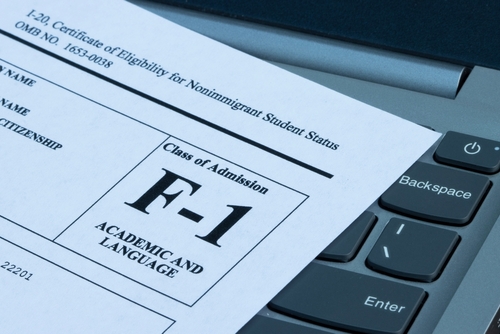At Remitly, we know that living internationally is an education in and of itself. If you’re choosing to study abroad in the United States, you’ll need an F1 visa. This is a non-immigrant visa specific for academic purposes.
Throughout 2025, applying for F1 visas has been a slower process because of interview freezes and pauses to visa acceptances. However, understanding the process and starting it well in advance of your intended travel to the US can help alleviate some stress. In this guide, we look to simplify the process so that you feel empowered and informed as you apply for your F1 visa.
What is an F1 visa?
An F1 visa is a student visa for international students entering the US for academic purposes. It allows international students to attend classes at an accredited college, university, or other academic institution. In addition to the F1 visa, there are other types of international student visas that cater to different educational needs and programs. For example, the M1 visa is designed for students pursuing vocational or non-academic courses. Understanding the various options helps students choose the best visa suited for their academic goals.
The F1 visa is a nonimmigrant visa. This means that the visa holder has to intend to return to their home country at the end of their studies.
With an F1 visa, international students can live and study in the US. In addition, they can take on paid employment within certain constraints. Students on an F1 visa can work up to 20 hours per week during school terms and full-time during breaks and vacation periods. On-campus work is permitted and off-campus jobs are allowed if they meet certain requirements.
The F1 visa is valid as long as the visa holder keeps valid student status and maintains their course of study. If you transfer to another academic institution, you typically will not have to reapply for another F1 visa as long as your initial visa is still valid.
Understanding the F1 visa requirements
The key eligibility requirements of the F1 visa are acceptance into a US school or institution that is SEVP-approved. SEVP stands for “Student and Exchange Visitor Program” and is part of the National Security and Investigations Division.
Applicants for an F1 visa must be enrolled full-time, demonstrate sufficient financial support, and have strong ties to their home country and intentions to return after the completion of their academic studies in the US.
Step-by-step guide to obtaining an F1 visa
Applying for a visa can be one of the most stressful parts of planning to move abroad for any length of time. And, like all visa processes, applying for an F1 visa is involved. However, despite being a multi-step process, it is not difficult if you understand the way it works. Knowing what to expect in advance can also help you manage the stress and get organised well in advance.
Follow the seven steps below to set yourself up for success when applying for an F1 visa to the US.
1. Receive the I-20 form.
An I-20 form is a document issued by the academic institution at which you’ll be studying. It’s also known as the Certificate of Eligibility for Nonimmigrant Student Status. This form will contain information vital to your F1 visa application. The I-20 will be physically mailed to you one to two weeks after your acceptance and enrollment at a school. Sometimes, the school will send you a digital copy of the I-20 or you can request one so that you can start the F1 visa process as soon as possible. You should keep this document on file for the duration of your studies in the US.
2. Pay the SEVIS fee.
Next, you’ll need to head online to pay the visa application fee to SEVIS by credit or debit card. This fee is known as the I-901 fee. Input your personal SEVIS ID, which is located at the top left of your I-20 form and your personal information, ensuring to keep all of the information consistent and accurate. The current SEVIS fee is $350 USD for F1 visas.
3. Complete the online Nonimmigrant Visa Application.
Fill out the F1 visa application form online. It is very important that all of the personal information that you input into this form is accurate and consistent, without any typos or spelling errors. It’s a good idea to ask a trusted friend or family member to take a look over your application to double check for any small errors. Make sure you note down and save your application number, which is an alphanumeric displayed at the top right of the screen.
4. Schedule your F1 interview.
Navigate to the US embassy website of your home country to schedule your F1 interview. The length of time you’ll have to wait to get an interview can really vary depending on your home country, so consider asking your local embassy for a guide on waiting times. Sometimes, there is an additional fee associated with scheduling the interview.
5. Prepare for the interview.
Visa interviews can be a fairly nerve-wracking experience, especially if you don’t know what to expect. The most important thing is to be as prepared as possible. Ensure that you have all the necessary documents in their original form as well as copies. You should also bring passport-sized photographs. Be prepared to surrender your passport to the embassy as they prepare your visa. Familiarize yourself with the visa application process explained on the official website of the embassy or consulate. This will help you understand any specific requirements or additional steps that may be necessary for your situation. Additionally, practicing common interview questions can help alleviate some of the anxiety you may feel during the actual interview.
6. Attend the visa interview.
To make sure things get off to a good start, make sure you arrive at the embassy at least 15 minutes in advance of your scheduled appointment time. During the interview you’ll be asked to present your documents. You’ll also need to answer some questions about your intended study and future plans. The aim of the interview is to assess whether you fulfil the F1 visa requirements, so they know your intention is to visit the US to study and you have no intention to overstay your visa.
7. Await your visa decision.
Once your interview is done, there’s nothing you can do but be patient. A few weeks after your successful visa interview, your passport with the visa inside will be sent to you by mail or you’ll be asked to return to the embassy to pick it up.
Tips for a successful F1 visa application
When you’re applying for an F1 visa, make sure that you start as far in advance as possible. The process can be quite drawn out and the last thing you want is to have to delay your studies. As you’ll need your SEVIS ID from the I-20 form to start the process, you should request a digital copy of the I-20 from your school or university as soon as you enroll. If they will not send a digital copy, request the SEVIS ID so that you can begin the payment process.
The DS-160 is a long and detailed document. Ensure that you give yourself enough time to fill out this form carefully and completely with accurate and up to date information. Another pair of eyes is always helpful, so consider asking someone to check over your answers so you can have peace of mind.
Financial support necessary for the F1 visa can be demonstrated by an official bank letter. This letter should be in English and should outline the amount of money available across your accounts. If you do not have enough money to cover one month of tuition, housing, and day-to-day spending, you can demonstrate financial support by submitting bank letters from parents and sponsors or scholarship letters.
It’s best practice to wait to buy any flights or book any travel until after you receive your approved visa. This is another reason why it’s important to start the application process well in advance and avoid any unnecessary delays.
FAQs
Can I work on an F1 visa?
Yes, F1 visa holders can work in the US. On-campus work is permitted and, in certain circumstances, off-campus employment is possible as well. Work is typically limited to 20 hours per week during school terms. However, F1 visa holders can work full-time during breaks.
How much bank balance is required for an F1 visa?
There is no set minimum bank balance associated with an F1 visa. However, you should demonstrate sufficient finances to cover at least one year of your academic program, including tuition, housing, and day-to-day expenses.
You can show your own finances when applying for an F1 visa or financial support from a parent, sponsor, or through scholarship letters.
How early can I apply for an F1 visa before my program starts?
You can submit your application for an F1 visa one year before the start of your program. It’s best practice to submit your F1 visa application as soon as possible. Regardless of when your F1 visa is approved, you cannot enter the US until the 30 day window before the start date of your program.
What’s the cost of applying for an F1 visa?
The SEVIS fee for F1 visas is currently $350 USD. There may also be an additional fee associated with scheduling the interview, so it’s worth checking details with your local embassy.

